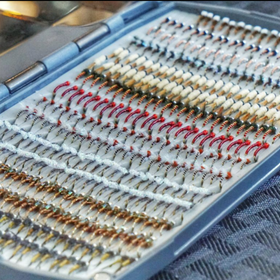Monday thru Saturday - 9am to 5pm
Sunday - 9am to 3pm
1532 Bergen Pkwy
Evergreen, CO 80439

Dorseys Mercury Black Beauty
For FASTEST PROCESSING, order by Noon MT
Store pickup available
The perfect winter midge. The mercury glass bead simulates the gas bubble that the emerging midge uses to rise to the surface.
"The original Black Beauty was invented in the early 1990’s to imitate the heavy concentrations of midge pupae found in tailraces below deep, bottom-release reservoirs.
Don’t let the simplicity of this pattern fool you—it consistently fools selective trout all over the United States.
While the original Black Beauty performs extremely well, adding a clear, silver-lined glass bead (Mercury Black Beauty) or combining a silver-lined glass bead and some Mylar tinsel (Flashback Mercury Black Beauty) increases the natural translucency when it comes to imitating an emerging pupa.
A tungsten Bead Head Flashback Black Beauty (swaps the silver-lined glass bead for a black tungsten bead) has the same goals in mind, but has a quicker sink-rate and works well for dry-and-dropper applications.
In its embryonic form, the Black Beauty had no name, it was just a generic black midge pupae that had earned a spot in my fly box because it was easy to tie, durable, and most importantly—it consistently fooled hard-fished, selective trout.
In March 1992, Bob Saile, Scott Ratcliff, and I named this pattern after a memorable trip on the Blue River near Silverthorne. On that day, Saile landed an 8-pound rainbow on my “black midge pupa” in a deep slot right below the I-70 bridge.
Saile’s rainbow measured 26 inches and had an 18-inch girth. It was an impressive rainbow to say the least!
Ratcliff and I had a day to remember as well; we also fooled some quality that day on the black midge pupa. On our way home from the Silverthorne-area, Ratliff said, “We really caught some beauties today. You ought to call your little black midge pupa the Black Beauty.” The name stuck, and the rest is history!"
- Signature Tyer Pat Dorsey








